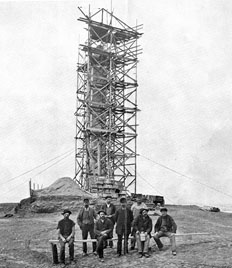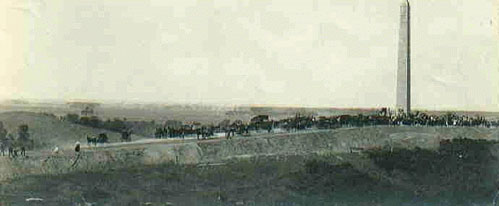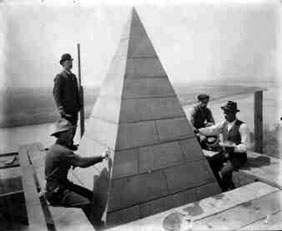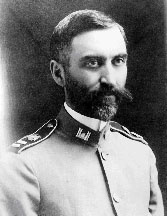 |
|
| Workers take a break from erecting the Sgt. Floyd monument |
|
On Memorial Day, 1901, a monument to Sergeant Charles Floyd was dedicated on a high bluff overlooking Sioux City, Iowa. The monument, a 100-foot-high white stone obelisk, similar to the much taller Washington Monument, commemorated a member of Lewis and Clark's "Corps of Discovery," who fell ill (probably of appendicitis), died, and was buried at that location in 1804. Floyd was the first American soldier to die West of the Mississippi River.
No member of the "Corps of Discovery" was a member of the Corps of Engineers, but Lewis and Clark helped prepare the template for countless expeditions to the American West led by engineer officers. Subsequent expeditions emulated the Corps of Discovery's efforts, not simply to map the West, but to collect information about the peoples, landscape, and flora and fauna. This omnivorous quest for information also characterized the designer of the Floyd Monument, Engineer Captain Hiram M. Chittenden.
Chittenden helped complete a road system at Yellowstone Park, and wrote a three-volume history of the fur trade in the Far West and a two-volume history of early steamboat navigation on the Missouri River. He also was an expert on flood control and contributed several important professional papers on the topic. His survey of reservoir sites in Colorado and Wyoming in 1897 helped prepare the ground for the establishment of the Bureau of Reclamation five years later. As Seattle District Engineer, he oversaw plans for the development of the Lake Washington Ship Canal. He probably was the best model of a Renaissance man the Corps ever produced.

Thousands attended the elaborate dedication ceremony for the monument, many arriving by a special train
that was provided free by the Sioux City and Pacific Railway Company.
A private group, the Floyd Memorial Association, raised most of the money for constructing the Floyd Monument. Congress donated the services of Chittenden as architect and engineer. The project appealed to Chitteden's historical interest and he worked on it with enthusiasm. Subsequent to the dedication, the Floyd Memorial Association presented Chittenden with a thirteen-volume set of the Life and Works of Francis Parkman and a resolution that recognized his work as a labor of love. The Corps also recognized Chittenden's efforts by choosing to display a model of the Floyd Monument as one of its exhibits in the St. Louis World's Fair in 1903.
 |
|
 |
| The monument's capstone was placed in April 1901. |
|
Capt. (later Brig. Gen.) Hiram M. Chittenden |
In 1960, the National Park Service designated the monument the first National Historical Landmark. Today, you can still see the Floyd Monument overlooking the Missouri River on Highway 75 near Glenn Avenue in Sioux City.
* * *
February 2002